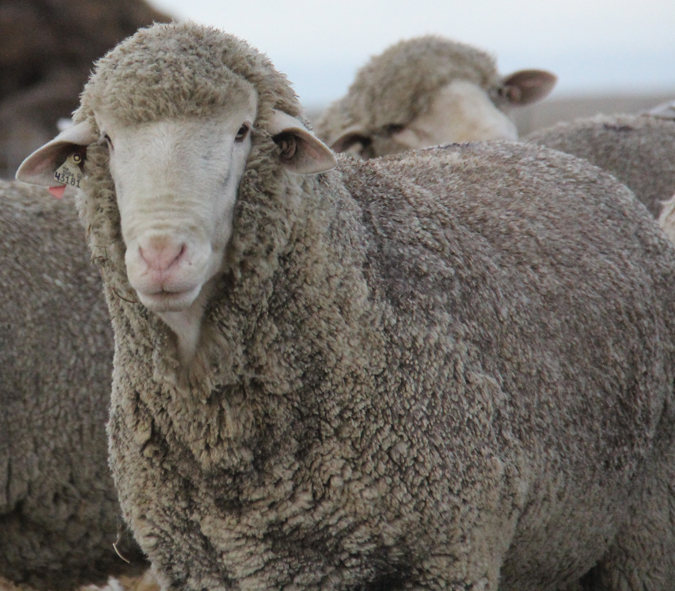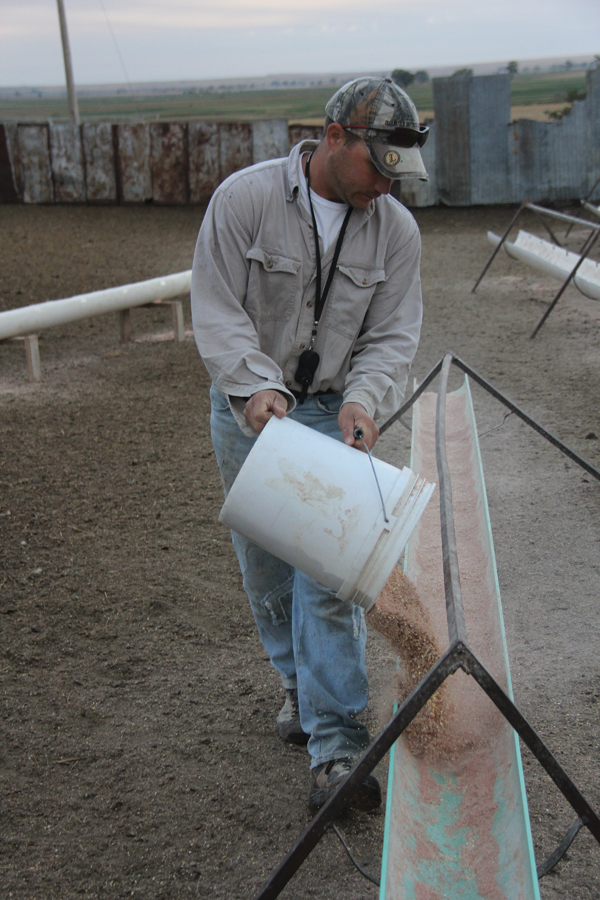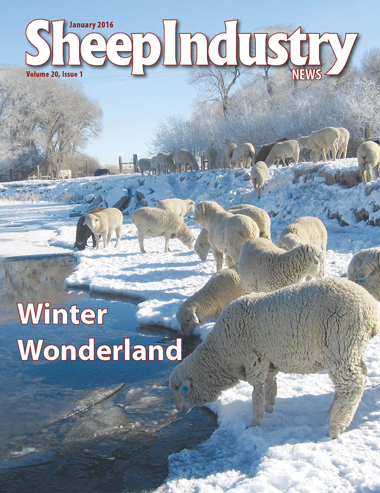Kitzan Clan’s Gamble
Family Advocates for South African Meat Merinos
KYLE PARTAIN
Sheep Industry News Editor
Flames shoot from the trash barrel between the house and barn, leaving little doubt about where I might find Josh Kitzan in the early-morning darkness just outside Nisland, S.D.
 Just a few feet from the fire, he’s preparing breakfast for the small flock of feeders he’s taken in from the nearby Newell Sale Barn. These aren’t the sheep I’ve traveled all this way to see, but they help the 27-year-old put food on the table for his wife and child as he works hand-in-hand with his father, Dwight, to establish the South African Meat Merino breed in the United States.
Just a few feet from the fire, he’s preparing breakfast for the small flock of feeders he’s taken in from the nearby Newell Sale Barn. These aren’t the sheep I’ve traveled all this way to see, but they help the 27-year-old put food on the table for his wife and child as he works hand-in-hand with his father, Dwight, to establish the South African Meat Merino breed in the United States.
There’s passion in his voice when he talks about the SAMMs. He offers research data and personal observations in an effort to win me over as a friend of the breed.
Surrounded by massive ranches running mostly Rambouillets, Josh and Dwight stick out like a sore thumb. As ranchers go, they are fairly new to the area. They haven’t passed down thousands of acres of pasture from one generation to the next, but have cobbled together an impressive operation in the last 25 years that continues to grow on the western side of the state.
This is their story.
Dwight is a second-generation sheep producer, while his wife, Gwendolyn, is a fourth-generation producer who was recently appointed to the Lamb Promotion, Research and Information Board by U.S. Secretary of Agriculture Tom Vilsack. But sheep were a side business for many years when the couple called North Dakota home.
Working in predator prevention, Dwight had one too many close calls in federal airplanes and eventually decided to keep his feet on the ground. Dwight’s brother was living on his family’s North Dakota farm and Gwendolyn’s brother was living on her family’s place, so the couple headed for new pastures in South Dakota.
It was 1989, Josh was just a year old and his sister, Karen, was 3 years old. Sheep became the family’s full-time business. Like many in surrounding states, the Kitzans had regularly attended the Newell (S.D.) Ram Sale and always liked the area. That led to them settling in nearby Nisland, ironically on Sheep Corner Road.
It wasn’t the easiest way to get a fledgling sheep operation off the ground, purchasing irrigated land in an area where many families already held thousands of acres thanks to homesteads settled by previous generations a hundred years ago. Regardless, the Kitzans have made it work, supplementing range ground with feed.
“The mistake we probably made all those years ago was buying the irrigated ground first,” Dwight admits. “What we didn’t know at the time was that the irrigated ground always comes up for sale. That range ground doesn’t go on the market very often. It’s a hard commodity to come by around here.”
In recent years, Josh has gotten married and given the couple their first grandchild. He and wife, Heather, bought their own place five or 10 minutes down the road.
“It’s just enough separation that we can do our own thing and they can do their own thing, but if one of us needs help we can still be there to help each other,” Josh says. “I didn’t want to get married and make my wife live in my parents’ basement. As far as the sheep, we run everything together.”
A few minutes later we’re headed toward Sheep Corner Road, where Josh is quickly put to work. Morning chores are numerous since most of the sheep are kept on his parents’ place.
“When they came here, dad had his pure-bred Suffolks and we were running Rambouillet range ewes just like most of the producers in the area,” says Josh. “Eventually, they registered the Rambouillets and we were selling some bucks that way. It was 1999 when we got into the SAMM deal.”
The family was already looking to make some changes in the mid to late 1990s when Dwight judged a show in Canada and was first exposed to the SAMM breed. Peggy Newman had used embryos from South Africa to create her Canadian SAMM flock.
“She was looking to retire and knew that dad had showed some interest in the breed,” Josh recalls. “So we ended up with these two bucks out of Canada just before BSE (mad cow disease) hit and they closed the border.”
The family crossed their SAMM bucks on a few Rambouillet ewes that first year and saw immediate results.
“The birth weight was actually a little smaller than the Rambouillets, but they got up and got to sucking right away on their own,” says Josh. “They were just so much more vigorous and grew extremely well. We were marketing Rambouillet rams at the time, and our buyers would come into the pen and see these half-Rambouillet, half-SAMMs and everyone picked them out. Those would sell out first, and then the Rambouillets would start selling. So, we knew there was something to this.”
The SAMMs proved to be excellent mothers, as well, with more than 70 percent successfully breeding as ewe lambs.
“That really sparked our interest,” Josh says. “So, we used those two bucks until we were about as line bred as we could get. Then, we had to stop and figure out the next step because there was no way to get a live animal into the United States at that point. We found a gal in Texas who had a buck from Peggy, so we got him.”
The SAMMs shared space with Suffolks and Rambouillets on the family ranch. But there was little doubt it was the SAMMs who were driving nearly every decision just a year or two into the experiment.
 Dwight and Gwendolyn made their first trip to Australia in 2008. While they dubbed it an anniversary trip, there was no doubt in anyone’s minds why they were headed down under. By that time, the Rambouillets were gone completely.
Dwight and Gwendolyn made their first trip to Australia in 2008. While they dubbed it an anniversary trip, there was no doubt in anyone’s minds why they were headed down under. By that time, the Rambouillets were gone completely.
The couple met with Australia’s top SAMM producers, several of whom had raided South Africa to grow their flocks. Australia, however, provided more in-depth information to help the family select the right rams. The Australian breeders shared their Lamb Plan data, which NSIP is now part of, and Hyden Edwards of Rockdale SAMMs was very open as to what SAMM bloodlines worked.
“Through the processing plant in Australia, they have a carcass competition,” Josh says. “We went on the internet and found the top producers that had won that competition consistently for the past 10 years, because they would have the truest SAMM bucks. That’s what we wanted, to get the top genetics out of Australia right away.”
Embryo transplant figured to be too expensive, so the family looked to artificial insemination as the best option for growing their SAMM flock. Dr. Martin Dally handles the AI procedure for the family.
“We do AI on about 40 head a year,” Josh says. “This spring will be our 16th year raising SAMMS. Once you get to that point, it’s a little easier to go on. The folks have been back to Australia a second time and picked up some more genetics, so we’re playing catch-up with all of that right now. We’ve chosen some different genetic lines and been able to find some that really work for us. We’re going to back off AI this year and really start to focus on what we’ve got.”
What they have is two SAMM flocks that are definitely distinct.
“Back when I was in FFA in high school, I needed a project to do and we were just getting our first line of half-blood SAMM ewes and Rambouillet crosses. So, I purchased 20 head from dad. All of my ewes and genetics go back to that first line.
“What we’ve found is that because the genetics are a little different, some bucks really work for him but just plain flop for me. We’re always doing something a little different. But we get a kick out of it, and we love it when we get to say, ‘I told you so,’ to each other.”
Dwight’s years of experience have helped him establish a routine that works on the family farm. When Josh first finished college at South Dakota State University, he did his best to push his dad toward new equipment and technological advances that might have made the daily chores a little easier on everyone.
“I had lots of grandiose ideas for dad, but what I learned after I got married and had my own place is that it’s a little harder to justify those things when it’s your money on the line,” Josh admits. “That’s where dad has been great, and I’ve learned to trust his opinion on those things. Sometimes you price out an idea, and then you know exactly why you’re not doing it.”
But not everything around Kitzan sheep is old school. Embracing the SAMM breed required everyone in the family to step outside their comfort zones in an effort to produce the type of sheep they believe the industry needs and wants.
The family has embraced the National Sheep Improvement Program, which uses stats upon stats to prove what Josh and Dwight already knew about their sheep.
“It just mirrors information,” Josh says. “But it’s also started to become a marketing tool for us. At first, we’d rattle off some of those numbers and producers didn’t have a clue what we were talking about. But we’ve done some education there with our buyers, and NSIP is doing a good job of educating the sheep industry about what they are trying to do. Once producers catch on to what the numbers all mean, they like what they see and what they hear.”
The Kitzan’s SAMMs are registered through the Merino Society, with in-depth flock lambing, production and loin eye records. They sell their breeding stock on index number. The Kitzans have also turned to NSIP numbers in their selection-making process.
“But it’s not the top end we’re worried about,” Dwight says. “It’s that bottom end that you have to bring up to an efficient level. For example, we’re trying to eliminate that triplet that gains below average. NSIP helps us identify those bottom end ewes much earlier – two to three years earlier – than we could with the numbers we were tracking on our own. That, to me, is the real strength of the program.”
As longtime ram sellers, Dwight and Josh understand the role they can play in shaping the sheep industry both locally and nationally. Josh, for instance, can see SAMM influence in some of the feeder lambs he buys in Newell.
“I cherry pick those because I know those lambs can perform well in a feedlot situation,” he says. “Lots of guys think they’re going to raise their own bucks and just jump right in. But it’s pretty intense some times. To do a good job, you have to have the measurements and be able to follow that ewe line and know the genetics for at least a couple of generations back. If you don’t, you can find yourself in some trouble pretty fast. Ram producers can have a huge impact on the industry in a very short amount of time.”
When done right, that’s a good thing.
“Right now, we can increase a guy’s drop – even on range – by 30 percent in two generations,” Dwight says. “These SAMMs are just so fertile and such great mothers.”
While the Kitzans are understandably proud of the SAMM flock they’ve produced in the past decade, they also understand that there’s a need for other breeds out there. Dwight, for instance, will probably always have a soft spot for his Suffolks. Fortunately, they cross well with the SAMMs. Nothing gains faster or has higher feed conversion with less death loss than a Suffolk/SAMM cross – aka Smutty lamb – they say.
“In all honesty, we’re more of a farm flock than anyone in western South Dakota,” Josh says. “The SAMMs fit our operation so nicely, and I think that could be said for a lot of the farm flocks back east that are in the same situation. They buy a lot of feed, and these animals are so much more feed efficient.”
While Rambouillets running on range can produce super-fine wool, the SAMMs generate a wool clip in the 23-micron range, but with yields in the mid-60s.
“Since we’re not running on range as much as those other guys, wool has never been our money maker,” Josh says. “The fall lambs are really what we concentrate on. But 23 isn’t a bad clip. That’s a really usable number for a lot of different things. We’re able to keep it pretty clean and its been yielding pretty well the last several years.”
Investing in SAMMs might have looked like a gamble at the time, but it appears to be paying off for the Kitzans.


